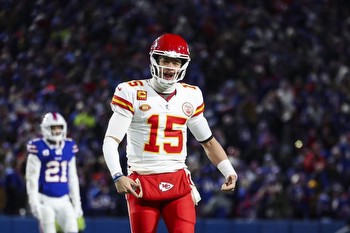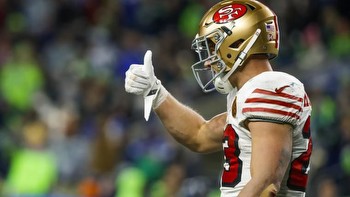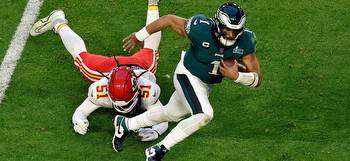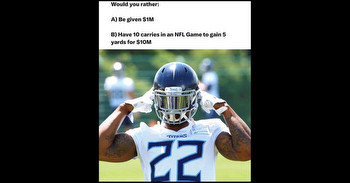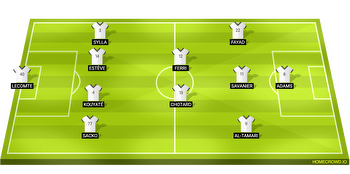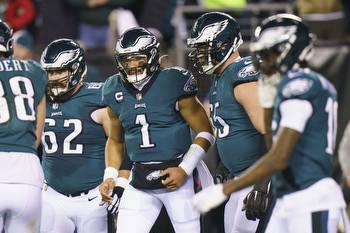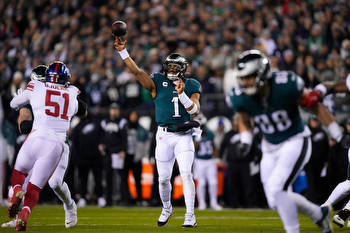Jalen Hurts, Jason Kelce made the Eagles' 'Tush Push' a weapon. The 49ers can stop it
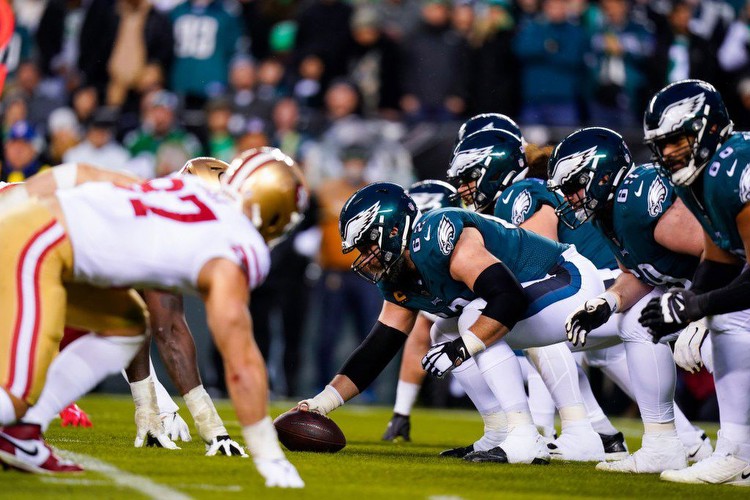
The NFL’s most famous play might also be its most straightforward.
And on Sunday, when the 49ers play the Eagles, it’s must-see TV.
You can call the play the Tush Push, the Brotherly Shove, or, simply, the Eagles’ quarterback sneak.
But no matter the moniker, Philadelphia has run it so often and so effectively that there have been calls for the league to ban the play.
“People can’t do it like we can,” Eagles coach Nick Siriani said in October. “Don’t ban this play. If everyone could do it, everybody would do it.”
In a league where offensive schemes are as layered as ever, there’s beauty to The Tush Push. The play works not because it’s ornate and complicated but because it’s simple and fundamental.
It’s a test of brawn in a sport that seems keen to move away from that sort of thing.
It’s a mass of humanity, seemingly picking up a yard (or more) at will.
Is it ugly? Absolutely.
Is it safe? Probably not. Other teams have tried it and injured offensive linemen and quarterbacks.
But the Eagles’ sneak is not unstoppable.
In fact, I think the 49ers have the secret to shutting it down.
And that’s massive heading into Sunday’s game in Philadelphia, because the Eagles are so good at this play, it gives them an advantage that seems small but proves itself to be massive in close games — like Sunday’s 49ers-Eagles could well be.
“Every first down is a first-and-9,” Siriani said.
“It changes the dynamics of the game,” Greg Cossell, senior producer at NFL Films, told me. “If it’s fourth-and-1 in their own territory, 99 percent of teams punt. The Eagles do not. They’ve become, essentially, a four-down team… It really changes how you play [defense] on second and third down.”
Tom Brady, arguably the greatest quarterback sneaker of all time, is not part of the chorus to ban the play.
“I like the way they’re doing it,” he said of the Eagles’ sneak last year. “They’re turning it into a rugby scrum a little bit.”
It looked like that to me, too. But I wanted to talk to someone who really knows rugby to confirm these suspicions.
So I called legendary Cal rugby coach Jack Clark, winner of 28 national titles since 1984.
He set me right.
Clark said it’s a stretch to say the Tush Push is the same as a rugby scrum, maul, or ruck.
That said, there are plenty of similarities in technique, and defenses must tap into them to beat the Brotherly Shove.
With both the Eagles’ Tush Push and a rugby scrum, success starts with the front line working in concert to create a space for the ball-carrier to move forward. This is typically done by three players forming a point.
In the case of the Eagles, the three-man point is the best left side of an offensive line in the game: left tackle Jordan Mailata, left guard Landon Dickerson, and center Jason Kelce.
“If you’re going to break a big piece of glass, and you walked up and slapped it with your hands, you wouldn’t break it,” Clark said. “But if you walked up with a ballpoint pen, you can, because of the directness of the point.”
(As if folks in the Bay Area need to be told about breaking windows.)
Behind the directness of the three-man point, a second line comes in behind them to add more force to the equation. It’s football, it’s rugby, it’s Newton’s Second Law of Motion.
But it’s not just a pile of men. It requires expert technique.
“In rugby, you spend a lot of time trying to find the accuracy of a bunch of people coming together and building something that can go forward,” Clark said. “How low can you get and still keep your feet driving?”
He sees the Eagles replicating that.
“You see these guys horizontal, but their feet are still going,” Clark said.
The result: the Eagles’ offensive line drives the line of scrimmage forward a yard or two, quarterback Jalen Hurts falls in behind them with the ball — sometimes with a push from behind him — and the Eagles have picked up a first down on third-and-1 or fourth-and-1 95 percent of the time this season.
So, how does a defense stop it?
The Tush Push has dominated because other teams defend it using football principles.
And as long as they do that, they’ll be pushed back every time.
Defensive line and linebackers aren’t assigned to take on individual offensive linemen; they’re assigned to penetrate or plug the gaps between them.
However, when the Eagles line up for the Tush Push, you’ll see no gaps.
By lining up foot-to-foot (or, in some cases, with overlapping feet), the Eagles line renders typical run defense tactics moot.
Flummoxed by this development, teams across the league have tried almost everything against this play. Most efforts have been embarrassing.
Try to take on the Eagles’ line from a side angle, and you will be pushed backward.
The same is true if you try to go higher or way lower. Going high, you’ll lose all your leverage and end up crowd-surfing. Going lower is a great way to be pushed face-first into the dirt.
But I think the 49ers know the answer: have the defense run the same play as the offense.
It was the game plan that Clark provided without prompting:
“The defense is going to have to get their pads lower than the pads of those offensive linemen and then mimic what those guys are doing,” Clark said.
“You can’t try to make a tackle. You have to try to take that space. They have to do the exact same thing the offense is doing.”
“If you try to hold them, you’re going backward,” Clark said. “But if you’re fighting for your two yards and they’re fighting for their two yards, there’s a chance you’re going to get some stalemates, and you’re going to win some of those.”
The Niners deployed this technique earlier this season, when the Minnesota Vikings tried replicating the Brotherly Shove in Week 7.
On the play, the Niners put six defensive linemen on the field and each was assigned to an offensive lineman on the other side. The defensive backs lined up on the side, marking the Vikings’ second row of pushers.
It was man-to-man; the Oklahoma drill on an NFL field.
And behind the line was linebacker Fred Warner, who was effectively playing the role of quarterback for the 49ers.
As the ball was snapped, Warner jumped over the line and sacked quarterback Kirk Cousins before he could drive forward. The play never fully developed, but it was evident the Niners were trying to embrace the principles of rugby, not football, at the line of scrimmage.
Warner wouldn’t confirm or deny if that’s what the Niners will do in Philadelphia Sunday.
“I can’t give away my game plan right now. I don’t want to give too much away. But we’ll have a plan for when they run it,” Warner said.
So yeah, that’s the plan. And I can’t wait to see if it works.
Because there is currently so little between the 49ers and Eagles, the NFC’s two best teams and the two teams with the shortest odds to win the Super Bowl this season.
One yard might prove to be the difference between a win or a loss.
And that’s not only for a Week 13 game, but in a future meeting between these two teams, perhaps with a trip to the Super Bowl on the line.
We know what the Eagles are running if they need that yard. It’s a play so effective people think it should be illegal.
I expect the 49ers to run the same play but on defense.
And amid that pile of humanity, I’m fascinated to see who comes out on top.


